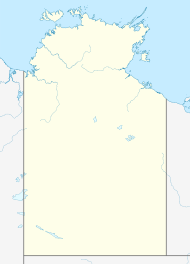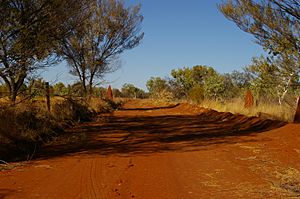Ali Curung facts for kids
Quick facts for kids Ali CurungNorthern Territory |
|||||||||
|---|---|---|---|---|---|---|---|---|---|
| Population | 394 (2021 census) | ||||||||
| Postcode(s) | 0872 | ||||||||
| Elevation | 375 m (1,230 ft) | ||||||||
| Location | 170 km (106 mi) from Tennant Creek | ||||||||
| LGA(s) | Barkly Region | ||||||||
| Territory electorate(s) | Barkly | ||||||||
| Federal Division(s) | Lingiari | ||||||||
|
|||||||||
Ali Curung (in the Kaytetye language, it's called Alekarenge; it used to be known as Warrabri) is a special community for Indigenous Australian people. It is located in the Barkly Region of the Northern Territory in Australia.
This community is about 170 kilometers (106 miles) south of Tennant Creek. It is also 378 kilometers (235 miles) north of Alice Springs. In 2021, a count of the people living there showed a population of 394.
Contents
History of Ali Curung
The community started as a special area for Aboriginal people in 1956. It was set up by the government's Welfare Branch. This happened because the water supply at another settlement, Phillip Creek, ran out.
Workers drilled two water bores in 1954. Buildings were put up in 1955. Then, people from Phillip Creek moved to Warrabri in mid-1956. The settlement officially opened on September 23, 1958.
It was managed by a superintendent and other non-Indigenous staff. The staff lived in special houses and huts. Aboriginal residents first built homes from metal sheets and bush timber. Later, some brick and aluminum houses were built.
The settlement had many important facilities. These included an electricity generator, an airstrip, and a garage. There were also stores, a vegetable garden, and yards for animals. A school, a small hospital (infirmary), a recreation hut, and a dining room were also part of the community.
How Ali Curung Got Its Name
The settlement was first called Warrabri. This name came from the two main Aboriginal groups who moved there. These groups were the Warumungu and Warlpiri people.
Later, a law called the Aboriginal Land Rights Act 1976 was passed. This law meant that Aboriginal reserves became Aboriginal land. After this, the name changed to Ali Curung.
The new name comes from places near the community. These places are linked to the Dog (or Dingo) Dreaming. In the Kaytetye language, which is spoken by the traditional owners of the land, these places are called Alekarenge. This means "dog/dingo-associated." The name is also used in the Alyawarr language.
Geography and Landscape
The weather in Ali Curung is very dry. The land around Ali Curung is dry for most of the year. There are no rivers or waterholes on the surface. People traditionally got water by digging at places called soakages.
The landscape has red sand plains and low hills. There are large areas of open spinifex grassland. You can also find scattered bloodwood trees (Corymbia opaca) and dogwood trees (Acacia sericophylla).
There are also areas with red-bud mallee shrubs (Eucalyptus pachyphylla). Other trees include mulga (Acacia aneura) and witchetty bush (Acacia kempeana). North of Ali Curung, you might see desert white gums (Corymbia aparrerinja), smooth-barked coolibah (Eucalyptus victrix), and Hakea chordophylla trees.
People and Languages
By 1958, just two years after it started, the community had up to 367 Aboriginal residents. There were also thirteen non-Indigenous staff members. By 1965, the population grew to 590. Around 1980, it reached about 790-830 people.
In the late 1970s, the Aboriginal population included:
- 35% Warlpiri people
- 20% Warumungu and Warlmanpa people
- 30-35% Alyawarra people
- 10-15% Kaytetye people
Warlpiri and Warumungu people often live on the west side of the community. Alyawarra and Kaytetye people tend to live on the east side. This is based on where their traditional lands are.
At the 2021 census, the community had 394 people. About 88.1% of them were Indigenous Australians. Only 23.1% of people spoke only English at home. Many other languages were spoken:
- 36.0% spoke Warlpiri
- 26.6% spoke Alyawarr
- 2.0% spoke Kaytetye
- 0.6% spoke Warumungu
Climate
| Climate data for Ali Curung, elevation 375 m (1,230 ft), (1991–2014 normals, extremes 1988–2014) | |||||||||||||
|---|---|---|---|---|---|---|---|---|---|---|---|---|---|
| Month | Jan | Feb | Mar | Apr | May | Jun | Jul | Aug | Sep | Oct | Nov | Dec | Year |
| Record high °C (°F) | 46.1 (115.0) |
44.8 (112.6) |
41.9 (107.4) |
39.3 (102.7) |
36.6 (97.9) |
33.3 (91.9) |
34.2 (93.6) |
35.4 (95.7) |
40.4 (104.7) |
42.1 (107.8) |
44.5 (112.1) |
46.0 (114.8) |
46.1 (115.0) |
| Mean daily maximum °C (°F) | 37.7 (99.9) |
36.8 (98.2) |
35.5 (95.9) |
32.3 (90.1) |
27.4 (81.3) |
24.2 (75.6) |
24.3 (75.7) |
27.0 (80.6) |
32.3 (90.1) |
34.9 (94.8) |
36.7 (98.1) |
37.8 (100.0) |
32.2 (90.0) |
| Mean daily minimum °C (°F) | 23.7 (74.7) |
23.1 (73.6) |
20.8 (69.4) |
16.4 (61.5) |
11.7 (53.1) |
8.3 (46.9) |
7.4 (45.3) |
9.1 (48.4) |
15.0 (59.0) |
18.6 (65.5) |
21.2 (70.2) |
23.1 (73.6) |
16.5 (61.8) |
| Record low °C (°F) | 15.8 (60.4) |
15.3 (59.5) |
10.1 (50.2) |
5.9 (42.6) |
1.0 (33.8) |
−2.5 (27.5) |
−1.2 (29.8) |
−1.0 (30.2) |
4.2 (39.6) |
7.3 (45.1) |
11.3 (52.3) |
14.8 (58.6) |
−2.5 (27.5) |
| Average rainfall mm (inches) | 76.4 (3.01) |
92.3 (3.63) |
27.1 (1.07) |
16.6 (0.65) |
15.9 (0.63) |
7.0 (0.28) |
5.9 (0.23) |
2.4 (0.09) |
11.6 (0.46) |
22.6 (0.89) |
35.0 (1.38) |
66.2 (2.61) |
379 (14.93) |
| Average rainy days (≥ 1.0 mm) | 5.7 | 6.8 | 2.6 | 1.4 | 1.8 | 0.8 | 0.9 | 0.5 | 1.4 | 2.8 | 3.8 | 6.0 | 34.5 |
| Source: Australian Bureau of Meteorology (rain 1991-2015) | |||||||||||||
How the Community is Governed
When the settlement first started, a superintendent managed it. Aboriginal residents were under the care of the Chief Protector of Aborigines.
In 1974, a report suggested that land in Aboriginal reserves should belong to Aboriginal people. This happened with a law in January 1977. The land title for Warrabri, and other reserves, was given to Aboriginal land trusts in 1978.
Before 1977, Warrabri had a council with Aboriginal members. From 1977, elections were held for a new council. This council better represented the local groups. The Ali Curung Community Government Council continued until 2008. Then, Ali Curung became part of the Barkly Shire. This is now called the Barkly Regional Council.
In 2007, Ali Curung became a "prescribed community." This was part of a special government plan. The Australian government took a five-year lease over Ali Curung. A Government Business Manager was put in place. Also, people receiving social security payments had half of their money set aside. This money could only be spent on important needs.
Economy and Work
When the Welfare Branch managed Warrabri, some Aboriginal people worked outside the settlement. They worked in farming and moving cattle. Others had regular jobs within the settlement itself.
In 2021, out of 394 people, 123 reported having paid work. Of these, 35.0% were unemployed. About 31.6% worked part-time, and 38.5% worked full-time.
Education in Ali Curung
The Warrabri School opened on May 9, 1956. In 1959, a manual training center was set up. It taught older students and young adults practical skills. Girls learned domestic science. Boys learned woodwork, leatherwork, and blacksmithing.
As of 2019, Alekarenge School teaches students from preschool up to middle school.
Fun and Culture
The Ali Curung football team is called the Kangaroos. They have been part of the Barkly Australian Football League since it began in 1991.
Culture festivals have been held in Ali Curung many times. These include the Pulapa Wirri ("big dance") in 1975 and 1976. The Ali Curung Dance Festival has been held every year during NAIDOC Week celebrations since at least 2010.
Several music bands have come from Ali Curung. These include the Ali-Curung Sundowners, led by Gus Williams. Other bands are the Warrabri Blue Grass Group, the Ali-Curung Spinifex Band, and Band Nomadic.
An arts center called the Arlpwe Arts Centre and Gallery started in 2008. It is owned by the Arlpwe Artists Aboriginal Corporation. The name "Arlpwe" describes the landscape around Ali Curung. It means "wide open space, clearing, flat country with no watercourses or hills" in the Kaytetye language.
A film called Kain was partly filmed at Warrabri. It was based on the story of Cain and Abel. The ABC and BBC broadcast it in 1967. It starred famous actors and also local people from Ali Curung.
It is important to know that there has never been any alcohol allowed in Ali Curung. The closest place to buy alcohol is at Wycliffe Well roadhouse.
Notable People From Ali Curung
In 1970, Teddy Plummer (Warumungu) received an award for his community service. He was a founding member of the Warrabri Cooperative. He also served as a president of the Ali Curung Council. A road in Ali Curung, Plummer Crescent, is named after him.
Other past presidents of the Ali Curung Council also have streets named after them. These include Billy Foster (Warumungu), Jack Jackson (Warlpiri), and Jimmy Newcastle (Warlmanpa/Mudburra).
Roads are also named after other important people. George Brown (Warumungu/Warlpiri) was the first Aboriginal police aide in Ali Curung. Tommy and Charlie Driver (Warlpiri) helped start Warrabri. Pete Peterson (Alyawarr) helped keep peace in Warrabri.
Country musician Gus Williams lived in Warrabri from 1976 to the early 1980s. Long Pwerle, a land rights activist, passed away at his home in Ali Curung in 1992.
Anthropologist Diane Bell wrote about many senior women in Ali Curung in the late 1970s. These women had great knowledge and authority in their culture.



